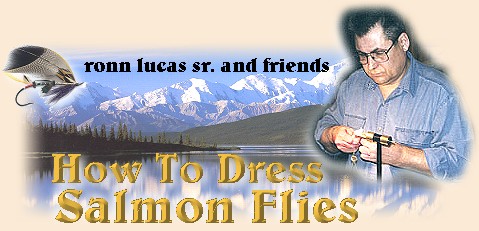
With the flowering of the British Empire also came some very
wealthy men with little or nothing to do. They turned to all
manner of interests to occupy their time, naturalism, chemistry,
exploration, religion, and art and field sports. Suddenly
fishing became one of the things to do! Tackle developed apace.
Advances in rods, reels (or winches) lines and our immediate
interest, flies.
Early salmon flies were merely big trout flies, on the premise
that bigger quarry needed bigger baits. These were fairly
rudimentary examples of what we now consider to be an art, just
wool bodies and feather wings, of convenient materials and rustic
colours. Eyes had not been developed on hooks, so gut loops were
whipped on the tapered shank as the first step in tying. However,
as a distant portent of things to come, grub patterns were also
used, probably as food imitations.
It was believed at that time that salmon ate butterflies, and
you can see where this is leading!
It seemed to follow in those days that as salmon fishing became
popular and was to be found at its best in the rivers flowing
through lordly estates, that the gentry would take up this new
sport with enthusiasm. They had the time, the money and above
all, the rivers.
The fact that salmon flies became the gaudy somewhat over-the-top
objets d'art that they did owes a lot to the fact that a rich man
fishing for the king of fish would feel it only fitting that he
should fish with a richly dressed and expensive fly. It was found
that these caught fish better than did their predecessors and so
the process started.
I have a book that I treasure greatly, How to Tie Salmon Flies
by Captain Hale. A classic, printed in 1892, it shows how the salmon
fly had reached a peak of opulent development, (or should we say
absurdity?) I know that eyebrows will be raised at my temerity
in using that word, but I really cannot feel that the salmon,
for whose benefit these gorgeous creations were intended, was
interested in or capable of discerning the myriad colours and
subtle shades deemed so essential at that time.
Consider, if you will, the dressing the worthy Captain Hale gives
us for the Jock Scott:
Tag: Silver twist and light yellow floss.
Tail: A topping and Indian crow.
Butt: Black herl.
Body: In two equal sections; the first, light yellow
flossed, ribbed with fine silver tinsel; above and below are placed
three or more toucan, according to the size of hook, extending
slightly beyond the butt, and followed by three or more turns of
black herl; the second half black silk, with a natural black hackle
down it, and ribbed with silver lace and silver tinsel.
Throat: Gallina.
Wings: Two strips of black turkey, with white tips
below; two strips of bustard and grey mallard, with strips of golden
pheasant tail, peacock sword feather, red macaw, and blue and yellow
dyed swan over, with two strips of mallard, and a topping above.
Sides: Jungle cock.
Cheeks: Chatterer.
Horns: Blue macaw.
Head: Black.
Tied on the size of hook prevalent at the time this was a serious
piece of work, not something you could run up on the tail of a
pick-up in response to a sudden hatch, but that a salmon could
discern those features which make a Jock Scott differ from, say,
a Silver Grey or a Black Rover, both flies of similar outline and
overall colour, is really beyond the realms of likelihood. Add to
this the fact that lists were drawn up, in all seriousness, of
which flies one was to use in various rivers, with the inbuilt
suggestion that salmon would refuse a fly lacking any of those
features deemed by the pundits to be essential for its own river!
On the Welsh Dee one was to choose from the following list: Jock Scott,
Butcher, Wilkinson, Black Doctor, Gordon or Grey Turkey.
On the Lancashire Lune however, a river not a million miles
away, emptying into the same bay of the Irish sea though its
drainage area is vastly different, one was almost commanded
to pick a fly from: Grey, Childers, Blue Doctor, Parson, Jock
Scott. The Wye was very different. It required a Sun Fly,
Colonel, Britannia, Black Dog or the ubiquitous Jock Scott.
The Tyne and the Tees in north-eastern England had to have
totally different flies in spite of being no more than thirty
miles apart.
Into this long-established routine, in the 50's, dropped a
revolution in pattern, size and more importantly in fly
construction. To say nothing of the hook.
We had, from time immemorial, sold Best Quality salmon flies
tied on black japanned, return shank, up-eyed hooks of a distinctly
Kirby bend, together with Second Quality flies, a much more
plebeian offering. These were more simply dressed, the expensive
exotic feathers being omitted, and tied on a plain down-eyed
bronzed Limerick hook, The fact that these would have tempted
salmon just as efficiently as their esteemed brethren never
seemed to come to light. The best people with more time to
fish the best waters naturally caught more fish. They also
used the best flies (they cost more so they must be better-nothing
changes!) therefore they perpetuated the myth that these complex
monstrosities were necessary in order to catch salmon.
Works of art they may have been, but their end was in sight.
A.H.E.Wood had brought about the first stirrings of revolution
with his theory of low water flies fished shallow on a greased
line. Anglers soon found that Wood's small, lightly dressed flies
took fish in normal and even in higher than normal water.
Smaller flies were on the way.
|





